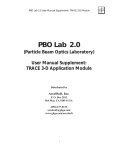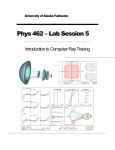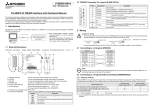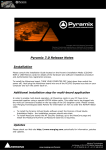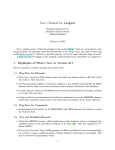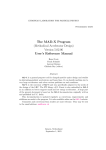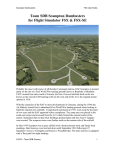Download High-level Software for Diamond Commissioning and Operation
Transcript
Proceedings of EPAC 2006, Edinburgh, Scotland THPCH112 HIGH-LEVEL SOFTWARE FOR DIAMOND COMMISSIONING AND OPERATION R. Bartolini, C. Christou, I.P.S. Martin, J. Rowland, B. Singh Diamond Light Source, Oxfordshire, UK. The Diamond accelerator complex is controlled with EPICS. Whilst generic applications are provided by the EPICS toolkit, accelerator physics applications for the commissioning and operation of the Diamond booster, storage ring and transfer lines are mainly developed with MATLAB. The MATLAB Middle Layer tools developed at ALS and SPEAR3 have been extensively used and extended with many new applications. Experience using these tools during the commissioning of the Diamond booster, transfer lines and storage ring are reported. The flexible nature of the Middle Layer has allowed the treatment of transfer lines, booster and storage ring to be standardised, with many of the applications developed for one part of the machine directly transferable to the rest. The Middle Layer has also provided a systematic way of managing machine data, and was easily extended to separate data from transfer lines, booster and storage ring. The Middle Layer communicates with the machine from within MATLAB using either MATLAB Channel Access (MCA) [6] or more recently LabCA [7]. Both these packages can also be used directly as required. INTRODUCTION COMMISSIONING AND OPERATIONAL APPLICATIONS Abstract As with many facilities worldwide, Diamond Light Source uses the Experimental Physics and Industrial Control System (EPICS) to monitor and control all accelerator and beamline hardware [1]. Channel Access is used as the interface to machine process variables (PVs), and simple tasks such as monitoring, alarm handling, display and setting of PVs are performed using EDM panels and striptools. However, for more complex accelerator physics applications, a collection of scripts written in MATLAB and Python are used. Early development of all high-level software was possible with development of a so-called “virtual accelerator” used to simulate the response of the electron beam to changes in power supply currents [2]. The virtual accelerator consists of the TRACY-II tracking code [3], wrapped into EPICS device support. Using the virtual accelerator, high-level applications were developed, tested and de-bugged at an early stage, and as such were available for day one of commissioning. The accelerator physics tools for Diamond make extensive use of the Middle Layer [4] and Accelerator Toolbox (AT) [5] software packages developed in parallel at the ALS and SPEAR3. These packages have been adapted for use at Diamond and extended to cover operation of the booster and transfer lines. In addition to the existing tools that come as standard with Middle Layer, many new applications have been developed for the commissioning and operation of the Diamond accelerators. Transfer Lines Beam emittance and Twiss parameters in both transfer lines are measured using the emgtool GUI, a screenshot of which is shown in Fig. 1 [8]. This application scans the gradients of the first two quadrupoles in the transfer line, recording the change in beam size using an OTR screen. Fits are then made to the data using 2D Gaussian distributions to extract the required values. EXISTING MATLAB TOOLS The Middle Layer is a library of routines that communicate with either the machine hardware or the AT model. It provides the user with a set of MATLAB routines for standard operational tasks such as accessing EPICS PVs, data measurement, storage and retrieval, unit conversion, and orbit and optics correction. The software is now mature and in routine use at several other facilities, a key consideration when selecting it for use at Diamond. 07 Accelerator Technology T04 Accelerator/Storage Ring Control Systems Fig 1: Screenshot of tool for measuring the emittance and Twiss parameters for the beam leaving the linac. Using the measured Twiss values at the exit of the linac, the corresponding Twiss parameters and dispersion 3065 THPCH112 Proceedings of EPAC 2006, Edinburgh, Scotland function at the OTR screen after the first dipole in the LTB are calculated by propagation with transfer matrices. This enables the beam energy spread to be measured by making additional fits to the beam size on the second screen using the dispg application. The accuracy of this measurement can be increased by varying the dispersion function and beam size at the screen location using the first 4 quadrupoles. The dispg application is now used routinely when optimising both the energy and the energy spread of the linac. Online matching of the optics in the first transfer line is performed using LTBQg which performs a least-squares minimisation of the beam size along the transfer line whilst constraining the Twiss parameters at the entrance and exit to the pre-defined and desired values respectively. Quadrupole gradients calculated using external matching codes can also set to the machine directly using LTBquadgui, and corresponding optics accessed from the AT model. Several applications exist for control of the beam trajectory in the transfer lines. The first allows the user to vary corrector magnet currents directly, whilst allowing the BPM readings to be simultaneously monitored. A script has been written to correct the beam trajectory to the centre of the quadrupoles in a piecewise fashion along the lines, and this has been used to check magnet and BPM offsets. Trajectory correction to the BPM centres using SVD can also be performed using the existing Middle Layer PlotFamily application. Control of the beam position and angle exiting the transfer lines is performed by varying the last two corrector magnet strengths simultaneously (see Fig. 2). The applications developed to do this use the AT model to calculate beam position and angle response at the septum to changes in corrector magnet strength, and invert this matrix using SVD to give the user full control over the beam trajectory. This capability proved valuable during commissioning, particularly for the set up of on- and offaxis injection into the storage ring. Booster The Diamond booster is a 100 MeV to 3 GeV ramping synchrotron, cycling at 5 Hz. Many new high-level scripts have been developed in MATLAB to be compatible with the data format required for this machine, such as functions to access vectors of BPM values during the ramp and the waveforms and operating parameters of the digital power supplies. These functions have all been designed to be compatible with existing Middle Layer functions. Orbit correction during the ramp is possible due to the ramping capabilities of the booster corrector magnets. The application boosterorbitcorrectiongui automates this process by acquiring vectors of BPM readings during the ramp and performing an SVD of the orbit response matrix to calculate vectors of corrector strengths as a function of time. These vectors are then interpolated and scaled to the main dipole current before uploading the ramp waveforms to the individual corrector power supplies. Python scripts have been developed to perform many tasks for Diamond, and it is envisaged these will be extended to provide applications for many of the routine operational tasks. These scripts use powerful graphics libraries to display real-time machine data such as first turn orbit, closed orbit during the ramp and tune measurements at injection calculated from the FFT of free-running turn-by-turn data. Fig 3: Screenshot of tool for plotting the closed orbit during the booster ramp. Fig 2: Screenshot of tool for controlling the position and angle of the beam leaving the BTS. 3066 Tracking of the tunes during the ramp was key to understanding and optimising booster performance during commissioning. The horizontal and vertical fractional tunes at injection and during the ramp can be measured simultaneously using the two types of BPM turn-by-turn data, and a MATLAB script has been written to acquire, download and process the data before displaying the tune signals as a function of time [9]. The booster RF cavity voltage ramp is also controllable through EPICS. The MATLAB application developed for this task contains in-built functions which allow the user to create any desired linear, triangular, sinusoidal, sawtooth or arbitrary ramp waveform, or alternatively allows any pre-defined ramp to be loaded from file (see Fig. 4). 07 Accelerator Technology T04 Accelerator/Storage Ring Control Systems Proceedings of EPAC 2006, Edinburgh, Scotland Once the required RF voltage ramp has been established, the application can then be used to upload the waveform to the low-level RF controller [10]. THPCH112 Analysis and control of the storage ring optics is to be carried out using the sropticsgui application. This program allows the user to determine the linear optics from any given set of quadrupole strengths using the AT model, or conversely calculate quadrupole strengths required to operate at any given tune point. A screenshot of this application is shown in Fig. 5. Fig 4: Screenshot of the RFramp application. Storage Ring Many of the tasks required in the storage ring can be carried out using existing Middle Layer functions, the majority of which are executable from within the PlotFamily GUI. Beam-based alignment, orbit, tune and chromaticity measurement and correction can all be performed using these tools. Linear optics characterisation is to be carried out using LOCO [11], and a GUI is available for this task. During commissioning of the storage ring, first-turn trajectory correction was performed using the storageringcorrectorgui. This application is similar to ones used in the transfer lines, in that it provides the user with a direct interface to all corrector magnet currents, simultaneously displaying all BPM first-turn readings. A flexible orbit correction program has been developed for storage ring commissioning. This program allows the user to define which orbit data is used for orbit correction. The user can choose between first turn data, orbit data averaged over any number of turns or orbit data corrected for saturated and non-linear BPM readings, all of which can be averaged over many samples. The application also allows the user to choose in which plane to apply correction, to select a threshold for singular value rejection and to apply only a fraction of the calculated correction. This application was found to be particularly useful during the early stages of storage ring commissioning, when limited numbers of turns were available, beam position varied shot-to-shot and uncorrected beam amplitudes were large. As in the booster, continuous tune measurements are provided graphically from the free-running BPM turn-byturn data using an FFT. Closed orbit and first turn after injection are displayed using Python tools. Simple channel access calls to the BPM electronics will also allow the user to view any desired turn number instead of the first turn, a feature which proved valuable during commissioning when investigating closure of the injection bump. 07 Accelerator Technology T04 Accelerator/Storage Ring Control Systems Fig 5: Screenshot of sropticsgui application. SUMMARY High-level software development for the Diamond accelerators has provided a set of tools for the commissioning and operation of the machine which have proved to be flexible and robust. These programs are straightforward to develop and are adaptable as circumstances require, often ‘on the fly’ during commissioning shifts. Production of high-level software is continuing for the remainder of the commissioning period and for routine operation. The authors would like to thank G. Portmann, A. Terebilo, D. Robin, J. Safranek and J. Corbett for a friendly and open collaboration regarding Middle Layer, AT and LOCO. Contributions from all members of the Diamond commissioning team in testing and developing the high level software are also gratefully acknowledged. REFERENCES [1] www.aps.anl.gov/epics/ [2] R. Bartolini et al., Proc. PAC 2005, p. 3188-3190 [3] J. Bengtsson., “TRACY-2 User’s Manual”, unpublished [4] G. Portmann et al., Proc. PAC 2005, p.4009-4011 [5] A. Terebilo, Proc. PAC 2001, p.3203-3205 [6] A. Terebilo, Proc. ICALEPCS 2001, p. 543-544 [7] T. Straumann, “labCA – An EPICS Channel Access Interface for SCILAB and MATLAB”, www.slac.stanford.edu/comp/unix/package/epics/ext ensions/labca/manual/ [8] C. Christou et al. “Commissioning of the Diamond Pre-injector Linac”, these proceedings [9] R. Bartolini et al., “Turn By Turn Data Acquisition and Post Processing for the Diamond Booster and Storage Ring”, these proceedings [10] C. Christou et al., “The Diamond Light Source Booster RF System”, these proceedings [11] J. Safranek, Proc. EPAC 2002, p.1184-1186 3067






